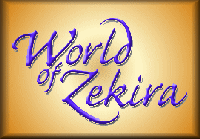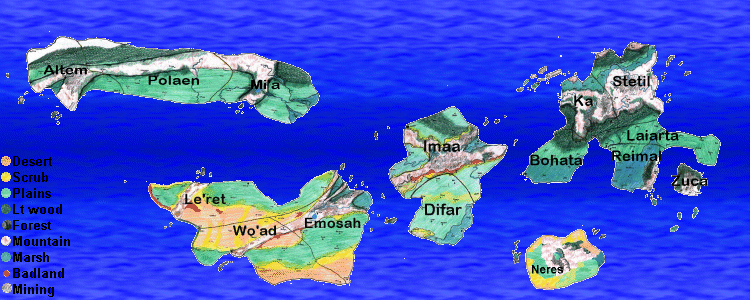
The Planet of Zekira
Where to find yourself
The World, it's structure, Lands, Areas, Cities
The native population lives exclusively on the southernmost continent called Neres. They are humanoid in appearance, bent and often squat, with much body hair and less in the way of language skills than Earthly humans would have at their point in evolution, they are violent and constantly warring among themselves. They know of the other population and have minimal contact with them, but have never developed the technology needed to cross the oceans — at least today, that is known. They may have been spread across other continents thousands of years before, but at this time there are no other pockets of civilization other than on Neres.
The planet of Zekira is not heavily populated, either by sentients or animal life. There is much vegetation, but unlike most water-rich planets, it has few rain-forests. Much of the plant life is tundra, evergreen, semi-arid grasslands, or otherwise non-tropical woodland. There are many ferns within the forests the nearer to the equator one looks, but nothing more complex. Therefore, also, there is a lack of tropical animal life.
There are no primates other than the two sentient populations (and it’s doubted that the imported ones can call themselves primates as we know them). The rodent population is huge and varied, with the most intelligent animals coming from this family. Next in variety are the grazers, then fliers. Insects abound, both over land and water, though there are no (or remarkably few) arachnids. There are no mammals in the waters of the world, though there are reptiles. Amphibians are rare, but occur on equatorial islands only. Fish run the entire gamut of Earthly styles and natures, grow to huge size, and include some bizarre mythic-seeming kinds.
When the colonists arrived, they brought with them seedlings to breed of wheat and barley, other grains, and fig-like trees that have not adjusted well to this world save for the wettest of areas. Native fruit-bearing trees abound, though, and citrus and banana-like trees being the most common. Other native grains have proven edible and in fact preferable to the bland-tasting older grains, and there is — of course — the equivalent of coffee here, called zpara.
But also brought from the stars were felines and equines. As grazers, the horse-like creatures did well from the beginning, and have situated themselves well in the ecosphere but are extremely prized, so very few of them can be considered ‘wild’, feral would be the only description of those Steeds that have escaped or been set free. The felines have a lot of native competition from the larger of the mustiline and rodent population, though they are mainly sought as personal pets, so they have their own niche within Zekira.
While Zekirans are generally known as "international", in that
they are often found on the move and rarely sit in one place for very
long (those who are able to, anyway), they do not have what might be known
as Countries.
Their City Zones, Areas and such comprise political and financial districts,
but not necessarily in a way which would set them up against one another.
The Zekirans see these Areas as more ways to count who has what and where
it is.
Each Land and Area however still has a sense of identity - and Zones
within the Areas as well. Some very proud Zekiran land Holders (those
who have just bought their first Hold?) like to wear colors reflecting
their Holdings.
Each Area has a specific style of patterning based on the shape and colors
of the Land.
Zerin's colors are Green and White - Bohata's pattern is a green vertical rectangle and white in the triangles; Ka and the Kan Islands has a narrow vertical strip on the left of green, with white on the rest; Stetil's pattern is a triangle pointing in from the left; Laiarta's has green on the top and bottom with white in the center; Reimal's flag carries a green vertical strip on the left and on the tips of the triangles; Zuca and the Zucan Islands is white with the inner lines of the triangles green.
Tana's colors are Black and Grey, though the Area flags also contain
white - Imaa is grey with a white stripe; Difar's is white with a black
stripe.
Curra's flag holds a brilliant blue background with a violet diamond
in the center. Pale blue and lighter purple are also used, in Altem's
the colors are light blue on the left of the violet diamond, and dark
blue on the right; Polaen's flag is dark blue with paler purple diamond;
Mi'a's is a simple reverse of the Area flag in purple and blue.
Kiran's flag is orange, red and yellow - Le'ret uses a diamond of yellow on the right, central stripe of red, and upper and lower orange; Wo'ad has the red at the right in a long diamond shape, orange on top, and yellow on the bottom; and Emosah has an orange triangle on the right, yellow stripe, and red on top and bottom.
Neres has no flag. Tresis on the other hand has his own ideas for the continent...
Several clever Steed breeders have actually bred their special racing or show Steeds into the colors of their Homeland. One or two Breeders of people have actually done the same thing. One of those Bred people announces Steed racers. Fancy that.

The World of Zekira has five major land masses, only four of which are populated by "Zekirans". The fifth is Neres, populated by the native humanoids.
Each of the Lands is subdivided into several large portions called Areas. Those Areas are then divided into Zones and Cities. Each city large enough to apply for "Zoning" must meet requirements of the Area, to be included as a separate part on the map. There are hundreds of tiny villages, bergs and outposts, as well as thousands of single Holds set down by individuals.
Land Holding is a complex and wonderful thing on Zekira. Each Land and Area has its own feel and look, so here are maps and descriptions of each Zone and Land/Area. In the Character Creation section are simple lists and charts to aid in locating your Holdings.
The Lands described here include the four Colonized continents, as well as a brief excursion over Neres. It is expected that there are far more small villages and townships which have not become Zoned (the "unincorporated Population"), as well as islands that are used frequently but too small to appear on the maps properly. Only the largest of islands are named, as well as those belonging to a specific person or family.
Roads are common between settlements, however there are myriad trails, pathways and hover-jet-burns as well that are not paved or officially kept up. Trade routes are established around rivers, but not necessarily dependant on water for travel: Zekirans don't like traveling on water, and they have flight capability already, so they have never needed to worry about it. Within a City Zone, depending on the population and general purpose, climate and locale, roads can be anywhere from 'dirt' to 'pressed styrocrete', framed by Steed droppings or fine works of art. It really just depends on where, who, how rich, and the weather.
Each Land is varied, and can be equated vaguely to Earthly equivalents. Not every locale has one, as there are unique settings here. Any further suggestions as to equivalents will be incorporated into future editions of the descriptions. Pictures are a bonus.
The Size Modifier and Value Modifier are two extremely important aspects
of Zekiran finance. An example of size and value is listed elsewhere -
but check those investment properties. Those with high Size or Value could
be a good place to put down a Homestead, office, or just leave it wild
as a park or hunting area.

Each of the four Lands has different Areas in it. To view a Land, just click on the image below!
